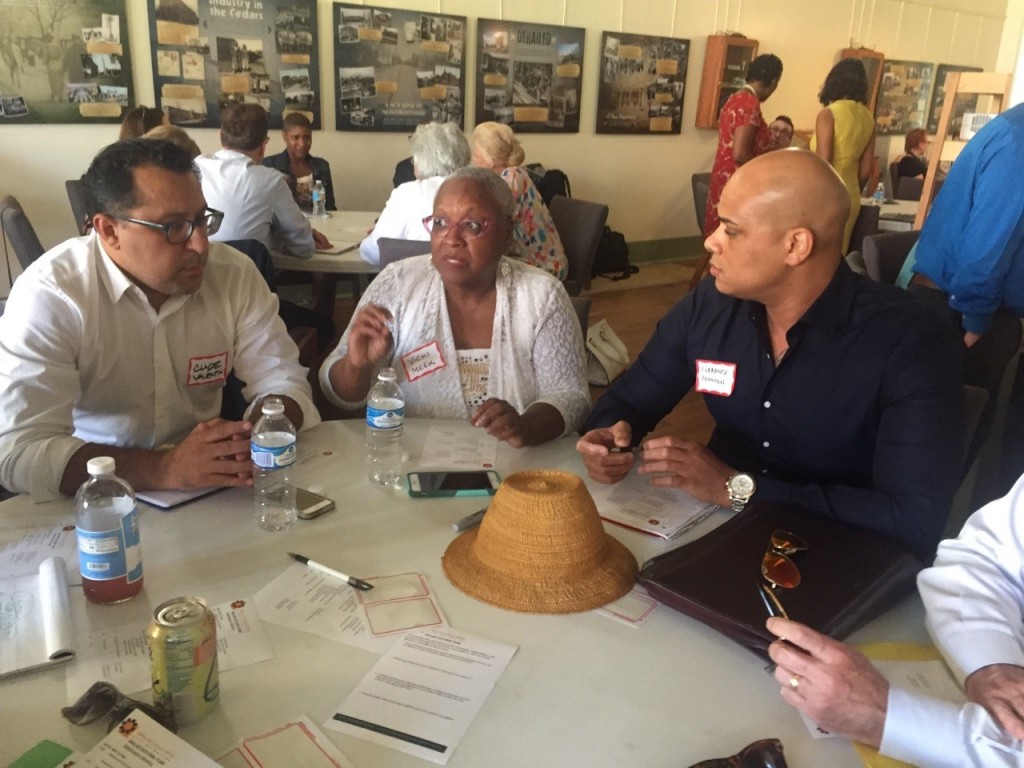The Beginnings Of A New Cultural Plan In Dallas
ArtandSeek.net July 27, 2017 22The City of Dallas is drafting a new cultural plan. But what should it focus on? Cultural Equity? Arts Education? Financial support for artists? Everything’s on the table. Art&Seek attended the first two public meetings that were hosted by the Office of Cultural Affairs and it appears that there are a lot of parties whose voices need to be heard.
On Tuesday afternoon, nearly 40 of the city’s artists, arts advocates and organization leaders gathered at Dallas Heritage Village to discuss the future of the arts.
Jennifer Scripps, Director of the Office of Cultural Affairs, gathered these individuals for a “mobilization meeting” that she says will help shape the city’s new cultural plan. Scripps dubbed the process a “once in a decade opportunity.”
“Thank you for caring enough about Dallas, your colleagues in the arts, the audiences and the people that we all serve,” Scripps said as she kicked off the meeting. “I hope that you all are as energized about today as we [at the Office of Cultural Affairs] are already.”
Everyone at the meeting is a member of the 2018 Dallas Cultural Plan Steering Committee. The OCA says the committee is made up of diverse community stakeholders. Members in attendance included Doug Curtis, President and CEO of the AT&T Performing Arts Center; Arthur Peña, artist/entrepreneur and Lily Cabatu Weiss, Executive Director of the Dallas Arts District.
Together with consultants – and a whole bunch of feedback from the public – the group will update the city’s cultural policy for the first time since November 2002. Already, there are a whole lot of ideas about what should be considered in the drafting process and what certain groups believe has to be included in the new cultural plan.
“I certainly think that the plan should engage with the idea of when we retain our artists, it develops our economy,” said Terrance Johnson, Artistic Director and Choreographer of the Terrance Johnson Dance Project. “Also, when other artists come to live here and buy things in the city and all of that, it improves the value of the city.”
Johnson wasn’t alone in discussing art and business. The Chairman of the Cultural Affairs Commission, John Paul Batiste, said the city has no business plan for the arts. And he thinks that should be a priority.
“I think we need to get away from the assumption that there is a model,” Batiste told the room. “If there is, it’s based upon survival and 14th century practices.”

SMU’s Clyde Valentín, artist Vicki Meek and dancer Terrance Johnson at Steering Committee Meeting. Photo: Hady Mawajdeh
Cultural equity was also a topic of discussion. Artist Vicki Meek, who was around when the first plan was created and has been a voice the Dallas arts community for decades, said if we want to serve communities appropriately then that term needed to be defined for the city and then used in the development of the plan.
“People have many ideas about what [cultural equity] is,” said Meek. “And I think that has been part of the barrier of [cultural equity] coming to fruition in the city.”
David Lozano, Cara Mía Theatre Co., echoed Meek’s concerns, but reminded the committee that we cannot forget about the years of insufficient resources that arts groups led by people of color have received over the past 50 years. And Zenetta Drew, Dallas Black Dance Theatre, said these groups can no longer be thought of as “token.”
Tuesday’s meeting wasn’t only for committee members to share their opinions. It was also a sort of meet-and-greet. Scripps introduced the consultant team that will help the city wrangle all these ideas, prioritize them and form a coherent approach to the arts.
Leading the project is Joy Bailey Bryant, of Lord Cultural Resources. Lord Cultural Resources is a global cultural consulting firm that offers services for museums, galleries and other cultural institutions (National Museum of African American History and Culture, Henry Ford Estate). This isn’t their first crack and aiding a city in the development of a cultural plan. Bryant and LCR worked with the City of Chicago on the cultural plan they rolled out in 2012. She says the citizens will create this plan and that she and her group just need to know what they want.
“What type of experiences are they looking for? How can we support that? How can we bolster that? How can we grow arts experiences across the city?” asked Bryant.
Lord Cultural Resources isn’t shouldering this project solo. They’ve tapped HR&A Advisors to create economic analysis and strategy development, Dallas’ Idyllic Interactive to handle communications and public relations and [bc] WORKSHOP to handle community engagement. [bc] WORKSHOP has already identified and collected data on 370 neighborhoods in Dallas.
“We have a pretty good understanding of the geography [in Dallas],” said Lizzie MacWillie, [bc] WORKSHOP’s Associate Director. “We have relationships not only with arts groups, but with neighborhood associations and community groups all across the city, so we’re going to work those folks, with [the committee’s] suggestions and other partners to really understand the existing conditions. And then [we’ll] map and analyze and process what these networks and people need.”
Bryant and her team of consultants also met with with the Cultural Affairs Commission on Wednesday morning at the Latino Cultural Center. The team went over their plan with the commissioners and most of them seemed excited about what’s to come. James White, a commissioner from North Dallas, asked challenging questions, but said later he’s excited about the prospects.
“With a plan like this we can build a framework and those stakeholders – all of us – will know these are the ways that the city can grow,” said White. “And these are the steel girders that will help support these structures as they grow.”
The process will take more than a year.













